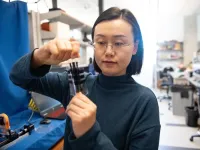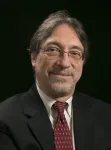(Press-News.org) The first panoramic view of infection pathways in the human placenta has been created, which could highlight potential drug targets to develop pregnancy-safe therapies for malaria, toxoplasmosis and listeria, all diseases that can cause severe pregnancy complications.
Researchers from the Wellcome Sanger Institute, the University of Cambridge, the University of Dundee, and collaborators, used novel ‘mini placenta’ models to map the placental response to infections in early development. This work is part of the wider Human Cell Atlas consortium1, which aims to map every cell type in the human body to transform our understanding of health and disease.
The study, published today (3 May) in Cell Systems, focused on the pathways involved in malaria, toxoplasmosis, and listeria infection, all of which can cause pregnancy complications and miscarriage. It revealed that secondary inflammation may be the cause of pregnancy complications during these infections and uncovered that placental immune cells are likely to play a defensive role against pathogens.
Future work focusing on identifying potential drug targets in the pathways that cause complications during infection could inform the design of more directed therapies to tackle infections in early-stage pregnancies.
Infections during pregnancy are a major global health concern2 affecting millions of people around the world. These infections can potentially cause maternal death, sepsis, and pregnancy complications, including miscarriage, foetal developmental conditions, low birth weight, and stillbirth3.
Malaria, toxoplasmosis, and listeria are widespread infections that can lead to pregnancy complications. This is of particular concern in regions where these infections are more common. For example, in Sub-Saharan Africa and parts of Southeast Asia where the malaria parasite Plasmodium falciparum is endemic4.
The placenta acts as a selective barrier during pregnancy, which allows nutrients to cross from mother to baby while blocking pathogens and toxins.
However, the pathogens that cause toxoplasmosis and listeria can cross the placenta, and the parasite responsible for malaria can attach to the outside. The foetus is particularly vulnerable during early-stage development as the immune response is not fully established, meaning that the foetus relies heavily on the placental barrier for protection.
Despite the impact of infections during pregnancy, the pathways and mechanisms these infections use to cross the placenta are poorly understood, partly due to the limitations of laboratory models used and differences between humans and mice.
In the latest study from the Wellcome Sanger Institute and collaborators, the team established ex vivo explant models, or ‘mini placentas’ from human samples5, which allowed them to map the response to infection at single-cell resolution.
The researchers identified a type of foetal immune cell, known as a Hofbauer cell, that were activated in all three types of infection but in different pathways. This is the first time that placental immune cells have been shown to play a defensive role against pathogens in a model of the human placenta.
The team found that pathogens can infiltrate these immune cells. For example, T. gondii, the parasite that causes toxoplasmosis, is likely to use these immune cells to evade the ongoing immune response and travel around the body.
They also discovered that all three infections induced a general inflammatory response in the placenta which dysregulated placental functions. This suggests that secondary inflammation may be the cause of some pregnancy complications.
Targeting these inflammation pathways could lead to pregnancy-specific treatment for infections, which is not currently possible.
In addition to this, the ‘mini placenta’ models developed by this team can be used in future research to gain more insights into placental response to infections as well as wider placental changes during development.
Dr Regina Hoo, co-first author from the Wellcome Sanger Institute, said: “While infections during pregnancy have been known to cause complications, including miscarriage and stillbirth, very little has been known about the underlying mechanisms. Our research shows that even with pathogens that cannot cross the placenta, the secondary inflammation from the immune system may be responsible for disrupting foetal development. Identifying key processes involved with the inflammation pathway could help us develop pregnancy-specific treatments that minimise this in the future.”
Elias Ruiz-Morales, co-first author from the Wellcome Sanger Institute, said: “We discovered that placental immune cells called macrophages can protect the placenta against infections. This is the first time that placental immune cells have been shown to play a defensive role in early-stage pregnancy in humans, and that these immune cells can be hijacked by toxoplasma during infection. Understanding more about how the placental immune system works can help give new insights into pregnancy complications.”
Dr Marcus Lee, co-senior author from the Wellcome Sanger Institute, now at the University of Dundee, said: “Millions of pregnancies each year are potentially exposed to malaria, and understanding how the parasite adapts during infection and how the body responds will be important in improving outcomes. However, studying the interactions between pathogens and the human placenta is understandably incredibly difficult and therefore the development of new models, such as the placental tissue system we used in this research, are a much-needed step forward.”
Dr Roser Vento-Tormo, co-senior author from the Wellcome Sanger Institute, said: “Infections during pregnancy can have devastating impacts, and there are limited pregnancy-specific treatment options that can help. By mapping the pathways involved in infection during early-stage pregnancy in single-cell resolution, and developing new placental models to study this, we hope that our research can be used by the research community worldwide to help develop new ways to understand and treat pregnancy complications that impact millions of lives every year.”
ENDS
Contact details:
Rachael Smith
Press Office
Wellcome Sanger Institute
Cambridge, CB10 1SA
Email: press.office@sanger.ac.uk
Notes to Editors:
The Human Cell Atlas (HCA) consortium aims to map every cell type in the human body as a basis for both understanding human health and for diagnosing, monitoring, and treating disease. An open, scientist-led consortium, HCA is a collaborative effort of researchers, institutes, and funders worldwide, with more than 3,400 members from 101 countries across the globe.
A, Seale. (2020) Recognising the burden of maternal infection worldwide. The Lancet. DOI: https://doi.org/10.1016/S2214-109X(20)30126-1
Chan MY, Smith MA. (2018) Infections in Pregnancy. Comprehensive Toxicology. Epub. DOI: 10.1016/B978-0-12-801238-3.64293-9.
World Health Organization, World Malaria Report 2023. Available at https://www.who.int/publications/i/item/9789240086173
All tissue samples were obtained with written informed consent from all participants in accordance with ethics guidelines and regulations.
Publication:
R. Hoo, E. R. Ruiz-Morales, I. Kelava, et al. (2024) Acute response to pathogens in the early human placenta at single cell resolution. Cell Systems. DOI: 10.1016/j.cels.2024.04.002
Funding:
This research was funded by Wellcome and UKRI. Full details can be found on the publication.
Selected websites:
University of Dundee School of Life Sciences:
The UK's Number 1 University for biological sciences (2014 and 2021 Research Excellence Framework), with scientists translating basic and clinical research to address global health challenges
One of the leading universities in the UK for spinning out and commercialising research, creating companies such as Exscientia and Amphista Therapeutics.
Our research-led teaching is preparing the next-generation of employable graduates with degrees that have a real-world focus.
University of Cambridge
The University of Cambridge is one of the world’s top ten leading universities, with a rich history of radical thinking dating back to 1209. Its mission is to contribute to society through the pursuit of education, learning and research at the highest international levels of excellence.
The University comprises 31 autonomous Colleges and 150 departments, faculties and institutions. Its 24,450 student body includes more than 9,000 international students from 147 countries. In 2020, 70.6% of its new undergraduate students were from state schools and 21.6% from economically disadvantaged areas.
Cambridge research spans almost every discipline, from science, technology, engineering and medicine through to the arts, humanities and social sciences, with multi-disciplinary teams working to address major global challenges. Its researchers provide academic leadership, develop strategic partnerships and collaborate with colleagues worldwide.
The University sits at the heart of the ‘Cambridge cluster’, in which more than 5,300 knowledge-intensive firms employ more than 67,000 people and generate £18 billion in turnover. Cambridge has the highest number of patent applications per 100,000 residents in the UK. www.cam.ac.uk
The Wellcome Sanger Institute
The Wellcome Sanger Institute is a world leader in genomics research. We apply and explore genomic technologies at scale to advance understanding of biology and improve health. Making discoveries not easily made elsewhere, our research delivers insights across health, disease, evolution and pathogen biology. We are open and collaborative; our data, results, tools, technologies and training are freely shared across the globe to advance science.
Funded by Wellcome, we have the freedom to think long-term and push the boundaries of genomics. We take on the challenges of applying our research to the real world, where we aim to bring benefit to people and society.
Find out more at www.sanger.ac.uk or follow us on Twitter, Instagram, Facebook, LinkedIn and on our Blog.
About Wellcome
Wellcome supports science to solve the urgent health challenges facing everyone. We support discovery research into life, health and wellbeing, and we’re taking on three worldwide health challenges: mental health, infectious disease and climate and health. https://wellcome.org/
END
Source of pregnancy complications from infections revealed by placenta map
2024-05-03
ELSE PRESS RELEASES FROM THIS DATE:
Lepra in the middle ages: New insights on transmission pathways through squirrels
2024-05-03
Researchers at the University of Basel and the University of Zurich have been able to prove that British squirrels carried leprosy bacteria as early as the Middle Ages. Further results revealed a link between the pathogens found in the medieval rodents and those in the local human population during that period.
Skin spots, deformed noses, ulcers: leprosy, is an infectious disease that can bring about some serious symptoms. The bacterium responsible, Mycobacterium leprae, which still infects around 200,000 people each year especially in the Global South, also has a long history in Europe. The international research group led by paleogeneticist Professor Verena Schünemann ...
The Foundational Questions Institute, FQxI, appoints Pinar Emirdag to Board of Directors
2024-05-03
The Foundational Questions Institute, FQxI, a philanthropically-funded science funding agency and think tank, is delighted to announce that Dr Pinar Emirdag has been appointed to the Institute’s Board of Directors.
Emirdag, a financial services executive and entrepreneur, is currently director of Hupomone Ventures, having previously spearheaded industry-changing initiatives at institutions such as JP Morgan, Citi and the London Stock Exchange and at start-ups including Lava Trading and Clearmatics. FQxI’s Chief Operating Officer Kavita ...
Stretchable e-skin could give robots human-level touch sensitivity
2024-05-03
A first-ever stretchy electronic skin could equip robots and other devices with the same softness and touch sensitivity as human skin, opening up new possibilities to perform tasks that require a great deal of precision and control of force.
The new stretchable e-skin, developed by researchers at The University of Texas at Austin, solves a major bottleneck in the emerging technology. Existing e-skin technology loses sensing accuracy as the material stretches, but that is not the case with this new version.
"Much like human skin has to stretch and bend ...
Researchers collaborate with the shipping industry to cut costs, fuel consumption and greenhouse gas emissions in shipping
2024-05-03
A common challenge in shipping occurs when ships arrive promptly at their destination, only to find a crowded harbour. Subsequently, they are often required to wait outside the harbour or anchor until port services and a quayside become available.
According to a report from the International Maritime Organization (IMO), it is not uncommon for ships to spend between 5-10% of their time waiting to enter port. Excessive speeds followed by extended waiting times with engines running result in a notable increase in fuel consumption. This is a problem that impacts both the climate and the economy.
Several European universities, ports, shipping companies and technology firms have now joined forces ...
Towards transparent and antimicrobial surfaces for touch displays
2024-05-03
The interest in antimicrobial solutions for personal and multi-user touch screens, such as tablets and mobile devices, has grown in recent years. Traditional methods like sprayable alcohols or wipes are not ideal for these delicate displays. Antimicrobial coatings applied directly to the glass are a promising alternative, but only if they are transparent and long-lasting. Previous proposed coating solutions, such as photocatalytic metal oxides (e.g., TiO2 and ZnO), have posed some challenges. Additionally, these coatings typically require light and moisture to be antimicrobial and eliminate the microbes present on the surface.
Copper ...
Number of male Oxbridge students from elite schools declined significantly in the middle of the twentieth century, study shows
2024-05-03
The number of male students at the University of Oxford from elite schools declined significantly by the middle of the twentieth century, a new study shows.
In contrast the proportion of female students remained steady. Those with fathers with professional jobs rose dramatically by the 1960s, according to the analysis.
At the beginning of the century around 25 to 35 per cent had fathers in professional occupations. This had risen to around 50 per cent among those arriving at Oxford in the 1960s.
The research, published in the journal Gender & History, was ...
A cost-efficient path to a renewable energy grid for Australia
2024-05-03
A model charts the most cost-efficient path to a fully renewable electricity grid for Australia. Raheel Ahmed Shaikh and colleagues modeled possible scenarios for Australia’s eastern and western grids, using solar and wind generation, short-to-long-term energy storage, and financial input data to explore low-cost capacity mix. Going completely renewable would require significant expansion of both generation and storage. Interconnecting the two grids would reduce generation capacity needs by 6% and storage power capacity needs by 14%. The least cost renewable-only grid would be dominated by wind, ...
Leadership in MS Rehabilitation recognized: John DeLuca, PhD, awarded 2024 Giants of MS® Honor
2024-05-03
East Hanover, NJ – May 3, 2024 – John DeLuca, PhD, of Kessler Foundation was named recipient of the 2024 Giants of Multiple Sclerosis® award for rehabilitation. He was one of seven inductees announced by NeurologyLive® and the Consortium of Multiple Sclerosis Centers (CMSC) this week. Dr. DeLuca is senior vice president, Research and Training at the Foundation and a professor in the departments of Physical Medicine & Rehabilitation and Neurology at Rutgers New Jersey Medical School.
Established in 2021, the Giants of Multiple Sclerosis award honors trailblazers, innovators, and visionaries ...
High rates of hip osteoarthritis among older adults with spinal deformity
2024-05-03
Waltham — April 30, 2024 — One-third of patients undergoing surgery for adult spinal deformity (ASD) also have severe osteoarthritis (OA) of the hip – which is associated with worse spinal alignment and physical functioning, reports a study in The Journal of Bone & Joint Surgery. The journal is published in the Lippincott portfolio in partnership with Wolters Kluwer.
These differences persist even following operative treatment of ASD, ...
ChatGPT can be helpful for Black women’s self-education about HIV, PrEP
2024-05-03
Waltham — May 3, 2024 — The artificial intelligence (AI) chatbot called ChatGPT is a powerful way for Black women to educate themselves about HIV prevention, as it provides reliable and culturally sensitive information, according to a study in The Journal of the Association of Nurses in AIDS Care (JANAC), the official journal of the Association of Nurses in AIDS Care. JANAC is published in the Lippincott portfolio by Wolters Kluwer.
"In addition to immediately available information, regardless of time or geographic location, privacy ...





